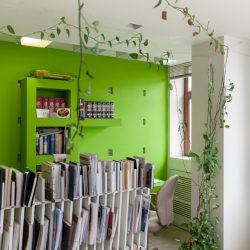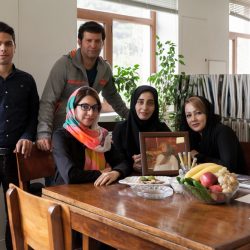AN IRANIAN BIMONTHLY ON ARCHITECTURE AND URBAN DESIGN
18 years for a person is an age of transition. It can be the beginning of adulthood where one gets to experiment with both right and wrong, enjoying the spirit of the young as one matures. But for a publication, 18 years is the period that practically guarantees experience and a knowing of all the ropes in the business in terms of both the publication and the people behind it, particularly magazines where the frequency of publication is higher. A magazine’s ability to produce content of such consistency while attracting readers’ interest for almost two decades is nothing ordinary (a part of it has to do with Iranian’s love for reading and the accessibility to the Internet that is comparatively lower to that of other countries, resulting in the popularity of print media still). The magazine we’re talking about is MEMAR, one of the first architecture magazines from Iran that still stands strong today. What’s special about MEMAR is not just the fact that it is packed with amazing architectural content, independent from the state and its ideology, but also the magazine’s vision towards Iranian architects and the architectural industry. And who would have thought that in the male-dominated architectural industry and an Islamic country such as Iran, the founder of MEMAR, Soheila Beski, is a woman who is not even a professional architect.

Photo by Ketsiree Wongwan

Photo by Ketsiree Wongwan
MEMAR’s first issue was published in July of 1998 as a quarterly publication before stepping up to bi-monthly in 2004. The architecture-related content is divided into different sections for each issue, ranging from short updates regarding what’s happening in the industry, reviews of new architectural and spatial design projects in Iran and other countries to in-depth interviews with prominent and up-and coming architects and articles about Iran’s traditional architecture. What we found to be the most interesting section that differentiates MEMAR from other architecture magazines is ‘Critique & Theory,’ which not only features the Farsi version of articles on various architectural issues by international architects such as Charles Jencks or Patrik Schumacher, but also reflects Beski’s belief that an architect is able to think about architecture better through ‘writing.’ While such belief became one of the magazine’s greatest challenges (particularly in MEMAR’s case where the writing is done by architects), it also made us realize that the contents in almost if not every issue of MEMAR have Iranian architects as their contributors, and in some cases guest editors.

Photo by Ketsiree Wongwan

Photo by Ketsiree Wongwan
WHO WOULD HAVE THOUGHT THAT IN THE MALE-DOMINATED ARCHITECTURAL INDUSTRY AND AN ISLAMIC COUNTRY SUCH AS IRAN, THE FOUNDER OF MEMAR, SOHEILA BESKI, IS A WOMAN WHO IS NOT EVEN A PROFESSIONAL ARCHITECT
The content featured or sometimes used as the theme of each issue ranges from the gentrification of Tehran where ancient architecture and public spaces are taken over by expanding urbanization (No.73), Tehran’s indigenous modern architecture between 1950 and 1970 with discussions and the sharing of points of view from Iranian architects’ and invited contributors such as Stefano Boeri (No.78), the photo essay issue that tells the many stories of the relationships between Iranian architecture and Art Deco (No.89) or the architectural theory issue that has Nashid Nabian of [Shift] Process Practice as the guest editor (N0.101). The latest issue (N0.102) features the stories and works of Armenian architects in Iran and their significant contributions to the foundation of Iran’s modern architecture through the influence of the West.
In addition to magazines and other publications, the annual MEMAR Award that Beski initiated in 2001 serves as another important mechanism that keeps the spirit of the industry up and alive with its internationally standardized selection criteria that divides the awards into four different categories; Residential: Individual Dwellings, Residential: Apartment Buildings, Public Buildings and Renovation. The MEMAR Award has brought new faces into the spotlight with almost all of the new generation and veteran Iranian architects whose works are featured in websites like ArchDaily or Dezeen having been selected for the award, not to mention the special international member of the jury invited each year such as Francisco Mangado, Han Tümertekin, or the internationally reputable Iranian architects like Nader Tehrani and Mohsen Mostafavi to select the winner of each category. The significance of MEMAR that Beski has reinforced throughout 18 years is not just creating a platform for Iranian architects to showcase their works and abilities, for it also serves as a bridge that links Iran’s architectural industry to the international arena. And while the peaceful passing of Soheila Beski two years ago was a great loss to the country’s architectural community, her vision for MEMAR and the path she has paved for the younger generation of architects will be continued with great determination and passion.

Memar Magazine, Photo by Ketsiree Wongwan
While the meaning of the word Me’mar or معمار†in Farsi has been given a more contemporary and relevant translation as ‘architect,’ looking back to the original definition of the word or ‘builder,’ it shares a similar connotation with ‘tekton’ in ancient Greek, ‘chang’ in Thai or ‘sala’ in Northern Thai. One can notice how the connotative meaning of Me’mar implies the possession of a set of skills at a more individual level compared to its contemporary definition. But regardless of its current interpretation or the etymology, MEMAR seems like the perfect name for one of Iran’s most important architecture magazines that will be celebrating its 19th birthday this July.
TEXT: PAPHOP KERDSUP
www.memarmagazine.com



























